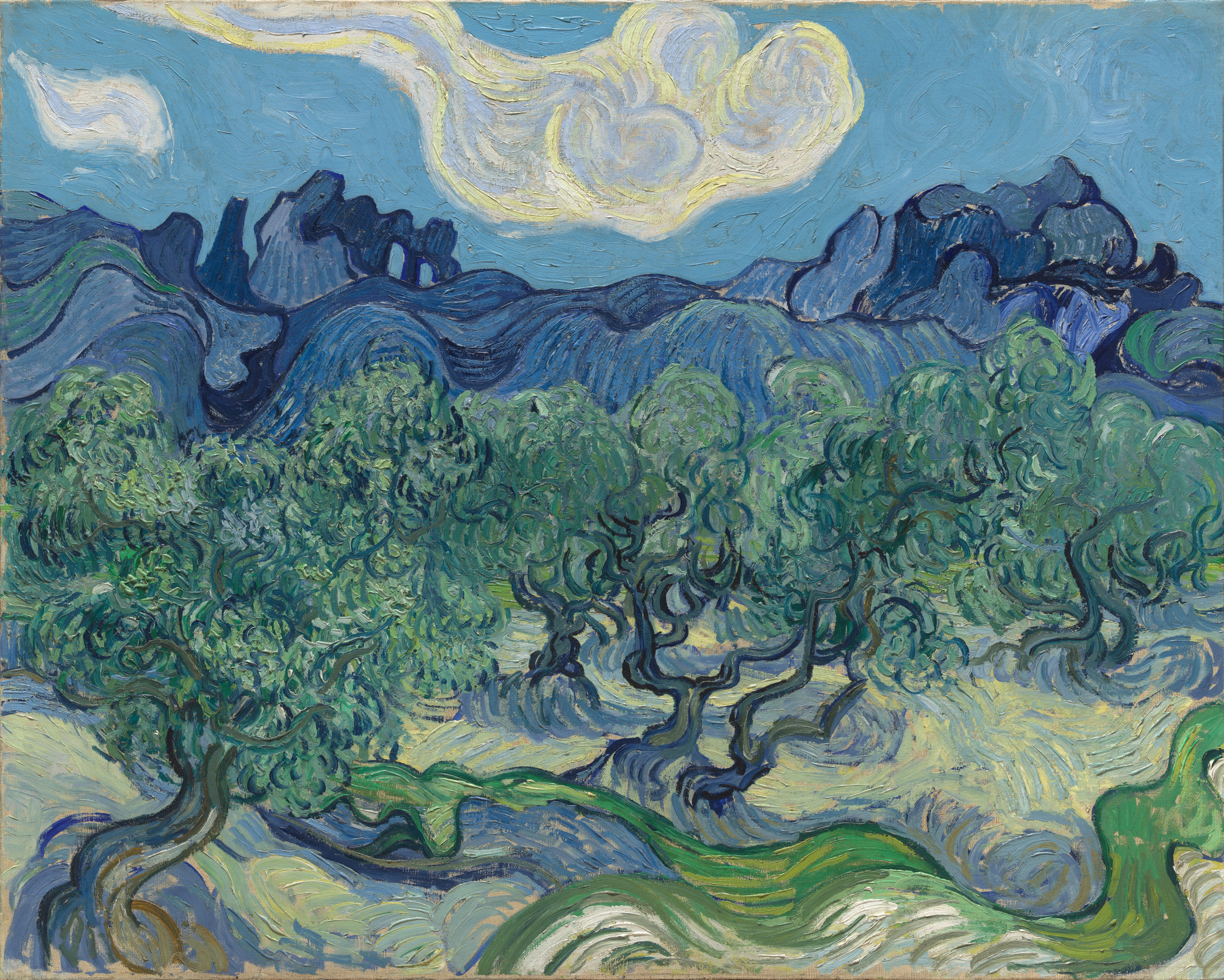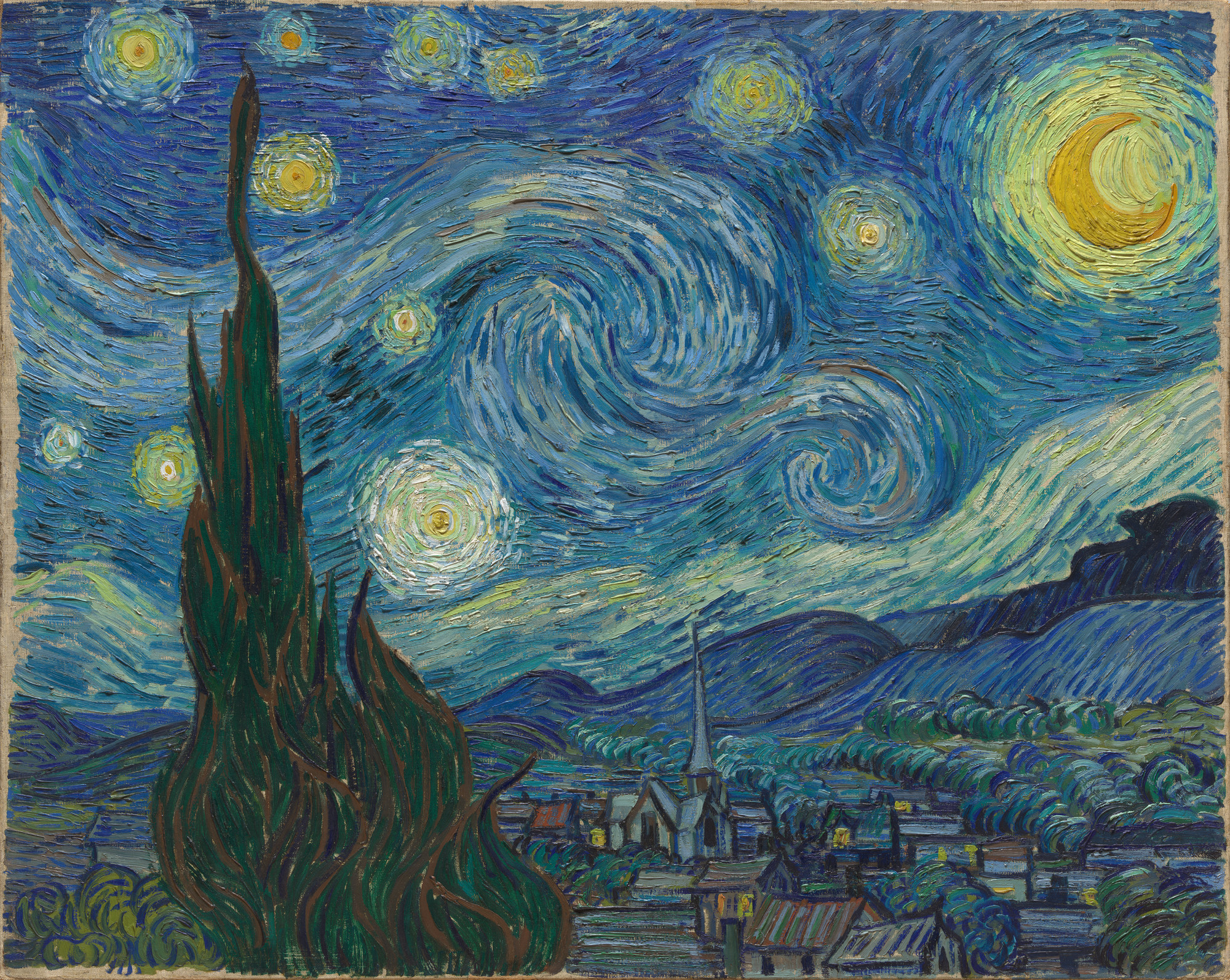Ben Tyson
Art
History
The
Cypress, a symbol of Provence for Vincent van Gogh
Most
of Van Gogh’s paintings during his time at Saint-Remy in Provence
France are natural landscape paintings. These paintings often include
core essentials such as fields (or open space), mountains, and skies.
Some of these landscapes will be peppered with trees. Of the two main
types of trees we see used in the landscapes, cypresses and olive
trees are primarily the most prominent and detailed. Both of these
types of trees have been noted to be symbols of Provence. But only
one of the types of trees ought to be regarded as the symbol of
Provence. The cypress when used in the landscape, becomes the main
subject of the painting. It is often singular compared to the olive
tree and is more detailed; it also tends not to blend in with the
landscape. Not only this, but in reproducing Wheat Field with
Cypresses, he takes time to better highlight the cypress in the
overall lighter tonal change of the paint style: which makes it
become the subject. Along with the renditions of Wheat Field with
Cypresses that highlight Provence in great detail, his masterpiece
Starry Night includes the cypress as the subject in the foreground of
the painting: giving it some fame in relation to Provence. The
cypress should be considered the symbol of Provence-related paintings
by Van Gogh because the cypress is often the singular detailed
subject of the landscapes unlike the olive tree.

1.
Wheatfield after a Storm, Vincent van Gogh, 1889,
Oil on canvas, Ny Carlsberg Glyptotek
This
piece serves as the vanilla version of one of Van Gogh’s
landscapes. This is to give the viewer a sense of the setting of the
landscapes at Saint-Remy. Notice
the recurring theme of these Provence landscapes with their blue
mountains, swirling skies, and green-yellow field. This is the visual
theme of Provence that we will see again. These landscapes are far
more numerous than the city paintings he did here.

2. Olive trees with yellow sky
and sun, Vincent van Gogh, 1889, Oil on canvas, The
Minneapolis Institute of Arts
Here we see an addition to the
formula that Van Gogh has created. With the sky and mountains as the
backdrop, the field in the foreground yields olive trees. This piece
is here to demonstrate that the olive tree is not in fact the symbol
of Provence. We see that there are numerous olive trees that fill the
field. They blend in the depth of the field to become a part of the
general scene. Not one of them is meant to stand apart from the rest.
Their detail also does not rival the rest of the painting.
3.
Cypresses, Vincent van Gogh, 1889, Oil on canvas, 49.30
Now we get a chance to look at
the cypress in the context of a Provence landscape. The angle changes
so that you cannot look into the field, thus the background is
larger. This also makes the cypress the lone subject of the field. We
see it up close from the ground angle as it takes up the foreground
of the painting as the subject. The cypress ends up blocking some of
the detailed sky and we instead see its intricate detail. Notice how
small the details become in the tiny swirls of the dark green
compared to the rest of the Provence landscape.

4. The Olive Trees, Vincent
van Gogh, 1889, Oil on canvas, Museum of Modern Art
We must be brought back to see
the contrast between the detailed singularity of the cypress against
another landscape that utilizes multiple olive trees. Again, we see
that it is indeed in the context of Provence and that trees take up
the open space again like before. The multiple trees also vary in
detail with the closest tree being the most detailed. Although it is
detailed, it is lost in with the rest of the forest because not
enough detail was given to make it stand out; its leaves blend right
into the other trees.
5. Wheat Field with Cypresses,
Vincent van Gogh, 1889, Oil on canvas, 1993.132
This was the piece of my
research. It is a typical Provence landscape including all three
elements aforementioned. It is here to be in contrast to the
following piece which is the remastered version. We see that this
painting is very detailed all around. The sky is heavily layered and
swirled and the cypress is dark yet detailed. I would argue that from
the changes that you will see in the remastered rendition, that it
was remastered in order to highlight the cypress as the subject.

6. A Wheatfield, with
Cypresses, Vincent van Gogh, 1889, Oil on canvas, The National
Gallery
This is the twin of the
aforementioned painting. It is considered to art critics to be the
newer painting of the two. We see that it takes a lighter tone than
before and the oil is not as thick as well. The detail in the bushes
is relaxed as not to disturb the cypress. The cypress is lighter in
color now so that you can notice the intricate details of the cypress
which is now more detailed than any other shrubbery. It is also
highlighted because the sky is not as dark anymore either. It is just
dark enough to pop out but not dark enough to miss the detail: making
it the subject of the landscape of Provence.

7. Starry Night, Vincent van
Gogh, 1889, Oil on canvas, Museum of Modern Art
Here we have another landscape of
Provence but at night. The cypress is not actually in the open space,
instead there are houses. It takes the immediate foreground of the
painting as the subject. Its darkness grounds the wild sky. Being the
subject of one of Van Gogh’s most respected paintings of Provence,
I would argue, is a reason to call the cypress not only a symbol of
the painting but an overall symbol of Provence. Not to mention the
other cypresses that are the subject of their landscapes that we have
seen.
No comments:
Post a Comment